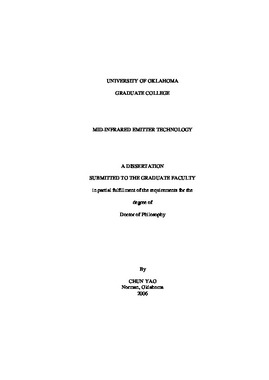| dc.contributor.author | Yao, Chun. | en_US |
| dc.date.accessioned | 2013-08-16T12:20:24Z | |
| dc.date.available | 2013-08-16T12:20:24Z | |
| dc.date.issued | 2006 | en_US |
| dc.identifier.uri | https://hdl.handle.net/11244/1104 | |
| dc.description.abstract | As part of an effort to improve heat dissipation from mid-infrared laser materials during operation, work was performed on mounting laser bars in an epi-side-down configuration. Results obtained from packaging interband cascade laser (ICL) bars provided by the Jet Propulsion Laboratory (JPL) were partially successful. Epi-side down packaged devices exhibited current-versus-voltage characteristics similar to epi-side up packaged devices, but mid-infrared emission was not observed when mounted devices were tested using a Fourier transform infrared (FTIR) spectrometer. | en_US |
| dc.description.abstract | To characterize the optical emission of the mid-infrared emitters, a filter wheel based mid-infrared spectrometer was developed to detect mid-infrared radiation between 1875 cm-1 and 3627 cm-1. Photoluminescence (PL) tests of a molecular beam epitaxy (MBE) grown IV-VI quantum well sample (MBE# W336) were performed using the filter wheel based mid-infrared spectrometer. By comparing the PL emission intensity to blackbody emission spectra, the cw PL emission power from the IV-VI quantum well sample at room temperature was estimated to be 0.183 mW when illuminated with a near-IR (911 nm) pump laser having a power of 970 mW. | en_US |
| dc.description.abstract | Mid-infrared emitters (3--30 microm spectral region) have numerous applications in spectroscopy and communications. Two major types of semiconductor material systems offer great potential for the fabrication of mid-infrared emitters with continuous wave (cw) operation at room temperature: IV-VI materials (lead salts) and III-V quantum cascade laser materials. Compared with quantum cascade lasers, IV-VI double heterostructure lasers are easier to fabricate, are widely tunable, and operate at lower voltages. | en_US |
| dc.description.abstract | Mid-infrared emission spectra for epi-side up packaged JPL ICLs measured using FTIR spectroscopy are presented and analyzed. Injection current tuning for ICL #J653 at 86 K was observed to be 0.10 cm-1/mA, while the tuning rate for ICL #J435 at 80 K was 1.2 cm-1/mA. This difference may be caused by different sized mesa stripes. ICL #J653 has a mesa width of 15 microm and a cavity length of 1.5 mm, while ICL #J435 has a mesa width of 150 microm and a cavity length of 1 mm. A smaller current tuning rate is consistent with less active region heating, and ICL #J653 with its thinner mesa width will have more effective active region heat dissipation due to better lateral heat flow normal to the laser cavity. (Abstract shortened by UMI.) | en_US |
| dc.format.extent | xiii, 183 leaves : | en_US |
| dc.subject | Semiconductor lasers. | en_US |
| dc.subject | Infrared radiation. | en_US |
| dc.subject | Infrared detectors. | en_US |
| dc.subject | Engineering, Electronics and Electrical. | en_US |
| dc.title | Mid-infrared emitter technology. | en_US |
| dc.type | Thesis | en_US |
| dc.thesis.degree | Ph.D. | en_US |
| dc.thesis.degreeDiscipline | School of Electrical and Computer Engineering | en_US |
| dc.note | Source: Dissertation Abstracts International, Volume: 67-10, Section: B, page: 5976. | en_US |
| ou.identifier | (UMI)AAI3237837 | en_US |
| ou.group | College of Engineering::School of Electrical and Computer Engineering | |
